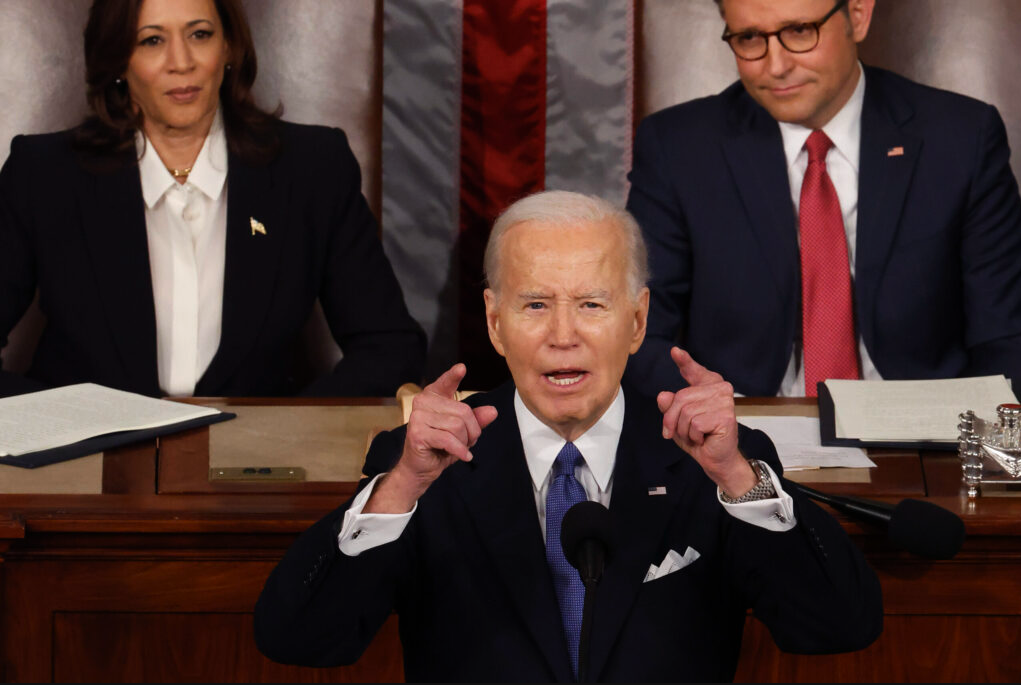Federal agencies react positively to proposed federal budget even though it’s dead on arrival in the Republican House –
Staff Report –
WASHINGTON, D.C. — Not wasting any time and showing what federal leadership looks like, President Joe Biden released a $7.3 trillion budget proposal on Monday for fiscal year 2025 that is packed with new spending on social programs and a wide range of efforts to combat high consumer costs like housing and college tuition, with tax increases on corporations and high income earners to pay for it all. It includes his call in the State of the Union for Congress to come up with $100 billion to strengthen border security and deliver aid to Israel, Gaza and Ukraine.
As the New York Times reported, the proposal includes only small changes from last year’s budget plan, which went nowhere in Congress, and this budget is also expected to be dead on arrival in the Republican controlled House. So the document will serve as a draft of Biden’s campaign policy platform as he takes on the presumed Republican nominee, Donald Trump, in the November election.
Biden’s political hand was strengthened considerably by a surprising and mangled Republican response to his address by Alabama Senator Katie Britt. After being portrayed hilariously on Saturday Night Live, the trending game shifted significantly in Biden’s favor on social media.
Will the momentum last? We will see. It depends on whether Democrats, independents and Republicans against a Trump authoritarian dictatorship realize the bots must be defeated in burying real news and information about current events, public affairs and politics by mass sharing of information on all social media platforms, especially those owned by Meta’s Mark Zuckerberg, including Facebook.
The budget is designed to portray Biden as a champion of increased government aid for workers, parents, manufacturers, retirees and students, as well as to continue the fight against climate change, which the Republicans continue to deny as a wedge issue to fool voters into voting for them.
“For too many hardworking families, it costs too much to find a good home, so we are working to lower costs and boost supply of housing nationwide,” Biden said.

Part of one of the memes now going around on social media portraying Biden as a patriotic super hero: NAJ screen shot
The budget proposal “restores the Child Tax Credit expansion I signed into law, which cut child poverty nearly in half in 2021. And it guarantees the vast majority of families high-quality child care for no more than $10 a day, while boosting pay for child care workers. It offers universal free preschool for all four million of America’s 4-year-olds.”
If Biden’s proposal were to be accepted by a responsible Congress, it would more than offset spending increases by imposing about $5 trillion in new taxes on corporations and the wealthy over the next decade, while Americans earning less than $400,000 a year would enjoy tax cuts totaling $750 billion.
“We can do all of our investments by asking those in the top 1 and 2 percent to pay more into the system,” said Shalanda Young, the director of the White House Budget Office upon releasing the plan.
Trump, on the other hand, is out there talking about further tax cuts for corporations and the rich, and issuing pardons to those convicted of crimes for their efforts to overturn the 2020 election and halt the peaceful transfer of power on Jan. 6, 2021.
While early, mostly irrelevant polls show Americans dissatisfied with Biden’s handling of the economy, mainly due to higher prices from inflation, “Biden has been unwavering in his core economic-policy strategy,” the Times reports.
Biden is also proposing about $3 trillion in new measures to reduce the budget deficit over the next decade by raising taxes on businesses and the rich and by allowing the government to bargain more aggressively with pharmaceutical companies to reduce spending on prescription drugs.
Biden once again calls for raising the corporate tax rate to 28 percent, up from 21 percent, the level in the tax bill he signed in late 2017 left over from the Obama administration. The proposal calls for an increase in the minimum tax on large corporations and quadrupling a tax on stock buybacks to raise more revenue from companies and individuals who make more than $400,000 a year.
House Republicans released a budget proposal last week that claims to reduce deficits much faster, ostensibly balancing the budget by the end of the decade. But their proposed savings rely on economic growth forecasts that are well above mainstream forecaster expectations, along with steep and unspecified federal spending cuts. The only way this plan could work would be by cutting Social Security benefits for retirees along with the retirement health care plan, Medicare. These cuts would be very unpopular with voters, so the Republicans are obscuring their plans with political balderdash.
The nonpartisan Committee for a Responsible Federal Budget called the Republican plan “unrealistic in its assumptions and outcomes.” The group on Monday called Biden’s proposed deficit reduction “a welcome start.”
Biden and his aides have repeatedly said they are comfortable that the projected deficits in his budget will not hurt the economy. Jared Bernstein, who leads the White House Council of Economic Advisers, repeated that position on Monday, even after acknowledging that the budget now forecasts higher government borrowing costs over the next decade than previous plans.
“Instead of pivoting to more aggressive deficit reduction, as prior Democratic presidents have done after losing control of a chamber of Congress, Mr. Biden has leaned into the need for new spending programs and targeted tax incentives to bolster growth and the middle class,” the Times reports.
Federal Agency Reaction
The heads of federal agencies began releasing their reactions to the plan on Monday morning, including NASA, EPA and Homeland Security.
NASA Administrator Bill Nelson seemed to welcome the plan, saying it will allow the space agency to continue advancing the understanding of Earth and space “while inspiring the world through discovery.”
“As history has proven … and as the future will continue to demonstrate, an investment in NASA is an investment in America for the benefit of humanity,” Nelson said. “President Biden’s budget will fund our nation’s abilities and leadership for the future of space exploration, scientific discovery, cutting-edge technology, climate data, the next generation of aeronautics, and inspiring our future leaders – the Artemis Generation.”
The budget will allow the launch of the Artemis II mission, which will send astronauts around the Moon for the first time in more than 50 years. It funds continued research into Earth’s changing climate, he said, as well as help commercial markets to grow and serve America’s interests in space. It should inspire the Artemis Generation of science, technology, engineering and math professionals.
“This budget shows NASA’s value in contributing to the global leadership of the United States,” Nelson said. “Every dollar supports our ability to continue exploring new cosmic shores and making the impossible possible, all while creating competitive and good-paying jobs in all 50 states.”
For NASA, the budget request would:
* Invest in the U.S.-led Artemis campaign of lunar exploration: The budget includes $7.8 billion for the Artemis campaign, which will bring astronauts – including the first woman, first person of color, and first international astronaut – to the lunar surface starting this decade as part of a long-term journey of science and exploration.
* Enhance climate science and information: The budget invests $2.4 billion in the Earth science program for missions and activities that advance Earth systems science and increase accessibility to information to mitigate natural hazards, support climate action and manage natural resources.
* Advance U.S. space industry technology development: The budget provides $1.2 billion for NASA’s space technology portfolio to foster innovative technology research and development to meet the needs of NASA, support the expanding U.S. space industry, which is creating a growing number of good jobs, and keep America ahead of competitors at the forefront of space innovation.
* Support highly efficient and greener commercial airliners: The budget invests $966 million in NASA’s aeronautics program, which will develop hybrid-electric jet engines, lightweight aircraft structures, and a major new flight demonstrator to pave the way for new commercial airliners that would be cheaper to operate and produce less pollution.
* Continue the transition to commercial space stations: The budget funds continued operation of the International Space Station, a vehicle to safely de-orbit the space station after it is retired in 2030, and the commercial space stations that NASA will use as soon as they become available.
* Increase STEM opportunities at minority-serving institutions: The budget provides $46 million to the Minority University Research and Education Project, to increase competitive awards to Historically Black Colleges and Universities, tribal colleges and universities, and other minority-serving institutions, and recruit and retain underrepresented and underserved students in STEM fields.
Reaction From EPA
“Following historic progress made since the President took office — with nearly 15 million jobs created and inflation down two-thirds — the budget protects and builds on this progress by lowering costs for working families, protecting and strengthening Social Security and Medicare, investing in America and the American people, and reducing the deficit by cracking down on fraud, cutting wasteful spending, and making the wealthy and corporations pay their fair share,” EPA Administrator Michael S. Regan said.
“President Biden’s Investing in America agenda and the FY 2025 Budget for EPA deliver bold environmental actions and economic benefits for communities across the county,” he said.
It will advance the agency’s ongoing efforts to address the most critical environmental challenges, he said, from combating climate change to ensuring clean air, safe water, and healthy lands. It will help protect communities from harmful chemicals.
“EPA’s work will benefit all Americans and we have made it a priority to ensure that a commitment to environmental justice is central to all of the agency’s efforts as we continue our work to help disadvantaged and overburdened areas become healthier, more resilient communities,” he said.
The budget makes critical, targeted investments in the American people that will promote greater prosperity for decades to come, he said.
At EPA, the Budget will:
* Advance Environmental Justice. The Budget bolsters the agency’s efforts to achieve environmental justice in communities across the Nation by investing nearly $1.5 billion in environmental justice-related programs. This investment supports the implementation of the President’s Justice40 commitment, which ensures at least 40 percent of the benefits of federal investments in climate and clean energy as well as infrastructure work reach disadvantaged communities, including rural and Tribal communities. These investments continue to support efforts to promote cleaner air and cleaner water, focusing on frontline communities.
* Urgently Tackle Climate Change. The Budget prioritizes combatting climate change with the urgency that science demands. The Budget includes $2.9 billion in climate-related programs to support work reducing greenhouse gas (GHG) emissions, building resilience in the face of climate impacts including engaging with the global community, expanding upon the GHG Reporting Program and Sinks Inventory, and implementing provisions in the American Innovation and Manufacturing Act to continue phasing out the production and import of hydrofluorocarbons.
* Invest in Clean Air. The FY 2025 Budget provides a total of $1.5 billion for the Office of Air and Radiation, an increase of $690 million since the beginning of the Administration, to continue the development of national programs, policies, and regulations that control indoor and outdoor air pollution and radiation exposure. This funding includes $423 million to assist EPA’s Tribal, state, and local partners in implementing their air quality management programs, an increase of $158 million from the current levels. Also included is $100 million for the Diesel Emissions Reduction Act Program, which funds grants and rebates to reduce harmful emissions from diesel engines, and $70 million for the Targeted Airshed Grants, which help reduce air pollution in the most polluted nonattainment areas. The Budget provides $186 million for the Federal Vehicle and Fuels Standards Certification Program, which develops analytical methods, regulations, and analysis to reduce GHG emissions from mobile sources.
* Support the President’s Goal of Replacing All Lead Pipes. The Budget includes a total of $101 million for two EPA grant programs dedicated to remediating lead contamination in drinking water—the Reducing Lead in Drinking Water grant program and the Voluntary School and Child Care Lead Testing and Reduction Grant Program—an increase of $53 million over 2021 levels. This investment, along with other programs at EPA that can be used for lead projects, builds on the historic $15 billion in direct funding for lead pipe replacement through the Bipartisan Infrastructure Law and underscores the President’s commitment to ensuring access to safe drinking water and creating good-paying jobs in the process.
* Invest in Critical Water Infrastructure. The Budget provides a total of $2.4 billion for the State Revolving Funds (SRFs) for drinking water and wastewater infrastructure, an increase of more than $1 billion over the current levels. The SRFs provide states with resources to fund high priority projects that improve human health and environmental conditions. These funds, and other water infrastructure programs within EPA, like the Water Infrastructure Finance and Innovation Act (WIFIA) credit program and the two $25 million grants programs focused on infrastructure resilience and sustainability, complement funding provided for water infrastructure in the Bipartisan Infrastructure Law. The Budget also includes $30 million for a new program that addresses gaps in resources to help improve the Federal response to water-related emergencies, such as the recent arsenic contamination of a public well in Coachella Valley, CA, and the drinking water access crisis in Jackson, MS.
* Safeguard Against Dangerous Chemicals and Protecting Public Health and the Environment. EPA has a responsibility under the Toxic Substances Control Act (TSCA) to ensure the safety of chemicals in or entering commerce and addressing any unreasonable risks to human health or the environment. The Budget invests nearly $132 million, an increase of $49 million above current levels to continue building core capacity and modernizing information technology and data software for the TSCA Program. The Budget also provides $208 million for Brownfields to support efforts to revitalize sites by awarding grants and providing technical assistance to Tribes, states, local communities, and other stakeholders to plan, inventory, assess, safely clean up, and reuse brownfields sites. Additionally, the Budget proposes approximately $170 million for EPA to continue addressing per- and polyfluoroalkyl substances (PFAS) through actions highlighted in the agency’s PFAS Strategic Roadmap.
* Continue to Build Back Capacity to Carry Out EPA’s Core Mission. The Budget adds more than 2,000 Full Time Equivalents (FTEs) relative to the 2023 Operating Budget, for a total of more than 17,000 FTEs. This continues to build back capacity for oversight of delegated programs, enforcement and compliance, land clean-up, grant deployment, public communication and engagement, and scientific research in support of all offices at EPA. These staffing investments will enable EPA to better serve the American people and protect public health and the environment.
* Ensure Compliance with and Enforcement of the Nation’s Environmental Laws. The Budget provides $260 million for civil enforcement efforts, which includes funding to prevent the illegal importation and use of hydrofluorocarbons in the United States. The Budget also includes $172 million for compliance monitoring efforts, including funds to conduct inspections in underserved and overburdened communities and rebuilding the inspector corps, and $77 million for criminal enforcement efforts. The agency will implement the National Enforcement and Compliance Initiatives to target these investments at the most serious environmental violations.
* Support State and Tribal Partners. The Budget continues to request additional resources to directly support EPA’s Tribal, state, and local partners with an investment of $1.5 billion in categorical grants, an increase of $304 million. This includes a new $25 million program to develop and fund Direct Implementation Tribal Cooperative Agreements to advance equitable implementation of EPA authorities and directives in Indian Country, which will include a focus on increasing resilience to climate change impacts.
“The Budget builds on the President’s record while achieving meaningful deficit reduction through measures that cut wasteful spending and ask the wealthy to pay their fair share,” Regan said.
Homeland Security
The budget plan provides $62.2 billion in discretionary funding for the Department of Homeland Security, as well as $22.7 billion for the Disaster Relief Fund to respond to major disasters and emergencies. It includes $4.7 billion for the Southwest Border Contingency Fund to resource border security and immigration enforcement efforts along the Southwest border.
When accounting for the effects of the Southwest Border Contingency Fund, the budget request for DHS is an increase of 10 percent above FY 2023. The budget includes a Transportation Security Administration (TSA) fee proposal that, if enacted, would decrease the discretionary funding request by $1.6 billion.
The agency’s border security and immigration enforcement efforts along the Southwest border “desperately require the additional funds requested by the administration and included in the Senate’s bipartisan border security legislation, which would provide DHS with approximately $19 billion to fund additional personnel, facilities, repatriation capabilities, and other enforcement resources,” Secretary of Homeland Security Alejandro N. Mayorkas said.
“The President’s budget, in combination with the Senate’s bipartisan border security legislation, is vital to meeting the needs of our workforce and the challenges we face,” he said.
It prioritizes staying ahead of the diverse and complex threats facing the homeland and “highlights the unwavering dedication to protecting the security of the American people,” he said. “This budget invests in our homeland security today and lays the groundwork to protect the American people well into the future.”
It supports efforts to advance the responsible use of Artificial Intelligence, as well as work to protect against malicious cyber threats to Federal networks and critical infrastructure, threats recognized by a large majority of the American people.
Related
Cyber Terrorism Viewed as a Top, Critical Threat by the American Public
The agency continues to call on Congress to pass the February bipartisan border security legislation to provide urgently needed resources and tools to frontline personnel. Biden’s budget also includes funding to combat the trafficking of fentanyl, to protect trade that is vital to our economic strength, to build resilience to climate change and strengthen recovery from natural disasters.
At the Department of Homeland Security, the Budget will:
* Advance the Mission to Combat Terrorism. The President’s Budget supports the Department’s continued efforts to combat terrorism, both domestically and abroad. The FY 2025 Budget funds the DHS Special Events Program, a critical program that gathers information on more than 57,000 special events, conducts risk assessments, coordinates Departmental and federal support thereto, and ensures that relevant information sharing occurs. The FY 2025 Budget provides $25.9 billion to meet core budget requirements of critical funding to U.S. Customs and Border Protection (CBP) and U.S. Immigration and Customs Enforcement (ICE). This funding would support CBP’s mission to protect the Nation from acts of terrorism and criminality with constant vigilance at and between the Nation’s POEs. As the principal criminal investigative agency within the DHS, the funding would support ICE, Homeland Security Investigations (HSI) with overseeing its responsibility to investigate, disrupt, and dismantle terrorist networks threatening or exploiting the customs and immigration laws of the United States. The President’s Budget also supports continued operational funding for the U.S. Coast Guard’s Maritime Security Operations, whose mission program encompasses activities to detect, deter, prevent, and disrupt terrorist attacks, and other criminal acts in the maritime domain. It includes antiterrorism, response, and select recovery operations.
* Help Secure the Border and Facilitate Lawful Trade and Immigration. The President’s Budget provides critical resources to secure our border while enforcing immigration laws that safeguard Americans from national security and public safety threats and support a humane, orderly immigration system. The Budget provides $25.9 billion to meet core budget requirements of CBP and ICE. This funding provides $2.5 billion to ICE-HSI to enhance investigative capabilities to combat Transnational Criminal Organizations that engage in the smuggling of humans, narcotics including fentanyl, firearms, and money. Additionally, the Budget invests $210 million to increase staffing capacity at the Southwest border, $86 million for CBP air and marine operational support, and $127 million for modernizing border security technology such as deploying new Integrated Surveillance Towers. The Budget also provides $145 million to U.S. Citizenship and Immigration Services to support timely processing of up to 125,000 refugee cases.
DHS reiterates previously submitted funding requests that are critical to secure the border, build immigration enforcement capacity, combat fentanyl and address domestic needs like natural disaster response, which Congress has failed to act on. Among them, the October funding request, which includes $8.7 billion for border, immigration, and counter fentanyl requirements and $9.2 billion for FEMA’s Disaster Relief Fund and Nonprofit Security Grant Program. Notably, the Administration’s border supplemental request includes funding to build capacity in the areas of border security, immigration enforcement, and countering fentanyl. DHS strongly supports the additional $19 billion in funding proposals included in the Senate’s bipartisan border legislation that would, among other things, enable DHS to hire more CBP agents and officers, ICE enforcement and investigative personnel, and USCIS asylum officers and provide new tools to bolster the Department’s efforts to secure and manage the border.
* Invest in Cybersecurity Protection and Emergency Communications. The President’s Budget continues to support the Cybersecurity and Infrastructure Security Agency’s mission to secure cyberspace and protect against malicious threats capable of compromising and disrupting Federal networks and critical infrastructure. The Budget includes $3 billion for programs strengthening cybersecurity, infrastructure security, and emergency communications. Notably, $470 million is provided for the Continuous Diagnostics and Mitigation program that enhances the overall security posture of federal networks and $116 million towards implementing the Cyber Incident Reporting for Critical Infrastructure Act, which requires critical infrastructure entities to report cyberattacks.
* Responsibly Deploy Artificial Intelligence (AI) Technology. The FY 2025 Budget includes $5 million for the Department’s Chief AI Officer (CAIO). The CAIO is responsible for setting priorities and directing policies and oversight for the responsible use of AI across DHS. To support this work, last month, the Department announced its first-ever hiring sprint to recruit 50 AI technology experts in 2024. The new DHS “AI Corps” will leverage this new technology across priority missions of the homeland security enterprise including efforts to counter fentanyl, combat child sexual exploitation and abuse, secure travel, fortify our critical infrastructure, enhance our cybersecurity, and deliver immigration services.
* Invest in a Disaster-Resilient Nation. The President’s Budget continues to support the Federal Emergency Management Agency’s (FEMA) mission to help people before, during, and after disasters. In addition to the $22.7 billion allocated to the Disaster Relief Fund, the Budget provides $3.2 billion in FEMA grants to improve disaster resilience and preparedness strategies at the State, Local, Tribal, and Territorial government level. It also provides additional resources for community-wide climate resilience initiatives. This includes an increase of $51 million for Flood Hazard Mapping and Risk Analysis, which will further expand FEMA’s inventory and leverage those maps to help communities better prepare for future conditions.
* Protect the Homeland from Threats of Weapons of Mass Destruction. The President’s Budget supports the mission of the Countering Weapons of Mass Destruction Office (CWMD), which protects the country from chemical, biological, radiological, and nuclear (CBRN) threats. The Budget provides $418 million to CWMD for its mission. This includes $181 million to fund programs supporting public and private sector organizations to improve technical capabilities and increase knowledge of CBRN threats.
* Increase Coast Guard Presence in the Indo-Pacific Region. The Budget provides $263 million to expand Coast Guard operations in the Indo-Pacific along three primary lines of effort: increased presence, maritime governance, and meaningful engagement. This investment supports acquisition of two Fast Response Cutters and increases training and engagement with partners, enabling the Service to transition from episodic to persistent presence in the region.
* Modernize TSA Pay and Workforce Policies. The President’s Budget continues to improve screening and security processes and honor previous commitments to the Transportation Security Administration’s (TSA) workforce to pay them at a level that is commensurate to their general schedule federal counterparts. The Budget includes $1.5 billion to ensure TSA employees do not suffer a pay differential. In anticipation of an increase in aviation passenger volume in FY 2025, the Budget also provides $365 million for additional Transportation Security Officers to staff airport checkpoints and $90 million for Checkpoint Property Screening System programs to more reliably detect aviation threats.
* Secure Special Events and the 2024 Presidential Campaign. The U.S. Secret Service (USSS) continuously evaluates threats and reallocates resources based on the changing threat environment. The Budget includes $70 million for Secret Service operations related to the 2024 Presidential Election to ensure the safety of major candidates, nominees, their spouses, and nominating conventions. It also provides USSS $16 million to procure necessary assets, personnel, and establish cross-agency communication centers for the 2026 FIFA World Cup. Finally, the Budget includes $19 million for other planned NSSEs that Secret Service is charged with protecting.
A responsible Congress would do well to at least consider and debate these budget proposals, not just oppose them in partisan fashion.
___
If you support truth in reporting with no paywall, and fearless writing with no popup ads or sponsored content, consider making a contribution today with GoFundMe or Patreon or PayPal.















